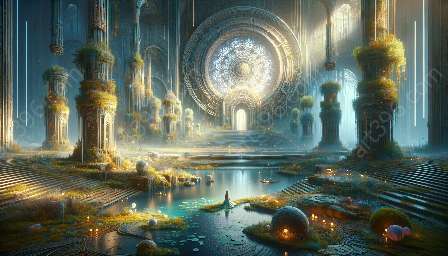Concept art is a vital component of the pre-production phase in animation, and it plays a crucial role in shaping the overall look and feel of the final product. As technology advances and artistic techniques evolve, the future of concept art is also poised for transformation. In this comprehensive discussion, we will explore the emerging trends and innovations that are redefining the field of concept art, with a special focus on their implications for animation pre-production.
The Impact of Technology
The integration of cutting-edge technology has been a game-changer in concept art. With the advent of virtual reality (VR) and augmented reality (AR), artists now have the ability to immerse themselves in their creations, allowing for a more intuitive and immersive design process. This shift has enabled a more fluid and dynamic approach to concept art, leading to a more cohesive and imaginative end result.
Furthermore, advancements in digital tools and software have revolutionized the way concept artists work. The use of powerful software applications and digital platforms has streamlined the creation process, offering greater flexibility and efficiency. This shift has not only accelerated the pace of concept art creation but also expanded the possibilities for experimentation and iteration.
Exploring New Mediums and Styles
As the boundaries of concept art continue to expand, artists are increasingly exploring new mediums and styles to push the envelope of creativity. Mixed-media approaches, unconventional materials, and experimental techniques are gaining traction, opening up fresh avenues for artistic expression and innovation. This diversity in mediums and styles not only adds depth and richness to concept art but also gives rise to a more diverse range of visual narratives and design concepts.
Moreover, the fusion of traditional and digital art practices has sparked a renaissance in concept art, blurring the lines between the physical and virtual realms. By combining traditional techniques with digital enhancements, artists can achieve a unique fusion of realism and imaginative freedom, resulting in concept art that is both evocative and technically refined.
Collaboration and Interdisciplinary Integration
The future of concept art lies at the intersection of collaborative creativity and interdisciplinary integration. With the increasing emphasis on cross-disciplinary collaboration, concept artists are being called upon to leverage their skills in tandem with professionals from diverse fields such as 3D modeling, animation, and storytelling. This collaborative approach fosters a holistic and integrated development process, ensuring that concept art seamlessly aligns with the broader creative vision and technical requirements of animation pre-production.
Furthermore, the integration of concept art with emerging fields such as interactive media, virtual production, and transmedia storytelling presents new opportunities for concept artists to influence multiple facets of the entertainment industry. By engaging with these dynamic domains, concept art professionals can contribute to the creation of immersive and captivating narratives that transcend traditional boundaries, propelling the art form into uncharted territories.
Adaptation to Evolving Narrative Formats
With the evolution of narrative formats in animation, concept art is evolving to meet the demands of diverse storytelling platforms. From interactive media and episodic content to feature films and virtual experiences, concept artists are adapting their craft to accommodate the distinctive needs of each format. This adaptive approach necessitates the exploration of non-linear storytelling, dynamic visual sequences, and user-driven experiences, prompting concept artists to engage in narrative prototyping and exploratory design.
Moreover, the rise of immersive storytelling through virtual reality and interactive simulations presents a paradigm shift in the way concept art contributes to the creation of compelling narratives. By immersing audiences in visually stimulating and interactive worlds, concept art becomes a pivotal catalyst in shaping narrative experiences that transcend conventional linear storytelling, reflecting a bold new frontier in animation pre-production.
Conclusion
The future of concept art is an unfolding tapestry of technological advancements, artistic exploration, collaborative endeavors, and adaptive storytelling. As the boundaries of concept art continue to expand, concept artists are poised to embrace a future characterized by boundless creativity, dynamic innovation, and a profound impact on animation pre-production. By staying attuned to these emerging trends and innovations, concept art professionals can position themselves at the vanguard of artistic excellence and narrative evolution, shaping the visual landscape of tomorrow's animation with unwavering ingenuity and visionary prowess.

